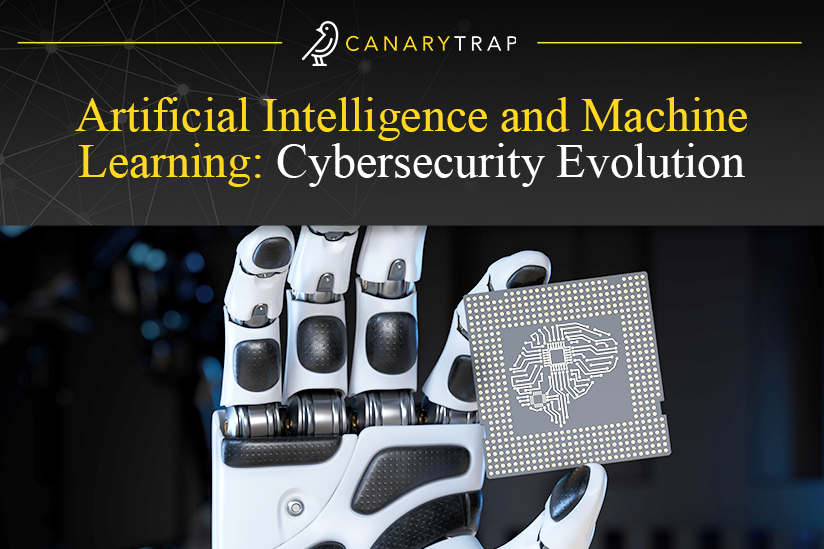Artificial Intelligence and Machine Learning: Cybersecurity Evolution
- February 23, 2024
- Canary Trap
In the rapidly evolving landscape of cybersecurity, Artificial Intelligence (AI) and Machine Learning (ML) have emerged as transformative forces, reshaping the traditional paradigms of defense. As we step into the intricate realm of AI and ML, it’s important to understand their pivotal role in fortifying digital landscapes against evolving threats.
It’s essential to recognize the dynamic synergy between AI, ML, and cyber security. Beyond mere buzzwords, these technologies form the bedrock of modern defense mechanisms, ushering in an era where proactive and adaptive strategies are imperative.
In this blog, we want to navigate the multifaceted relationship between AI, ML, and cybersecurity, unraveling the complexities and unveiling the potential for a more resilient digital future. Let’s dissect definitions and applications to understand the profound impact of AI and ML on the cybersecurity landscape.
Defining Artificial Intelligence and Machine Learning
In our journey through the intricate landscape of cybersecurity, it’s imperative to illuminate the transformative forces propelling the industry into a new era. At the forefront of this revolution stand two game-changing technologies: Artificial Intelligence (AI) and Machine Learning (ML). These aren’t just abstract concepts but rather dynamic tools reshaping how we safeguard digital domains against evolving threats.
- Artificial Intelligence (AI)
Envision AI as the architect of digital intelligence. It encompasses the development of computer systems with the capacity to execute tasks that traditionally demand human intelligence. From learning and reasoning to problem-solving, perception, and language understanding, AI broadens the scope of what machines can achieve. AI systems range from rule-based engines to sophisticated models capable of autonomous learning.
According to Columbia Engineering, “Today, artificial intelligence is at the heart of many technologies we use, including smart devices and voice assistants such as Siri on Apple devices. Companies are incorporating techniques such as natural language processing and computer vision — the ability for computers to use human language and interpret images — to automate tasks, accelerate decision making, and enable customer conversations with chatbots.”
- Machine Learning (ML)
Nestled within the realm of AI, ML serves as the engine powering the learning capabilities of computer systems. Unlike conventional programming, ML enables systems to enhance their performance iteratively through exposure to data. This iterative learning process equips ML systems to adapt to novel information and dynamic scenarios, marking a departure from static, rule-based approaches.
Columbia Engineering defines ML as a pathway to artificial intelligence. “This subcategory of AI uses algorithms to automatically learn insights and recognize patterns from data, applying that learning to make increasingly better decisions. By studying and experimenting with machine learning, programmers test the limits of how much they can improve the perception, cognition, and action of a computer system.”
In the context of cybersecurity, the synergy between AI and ML is revolutionary. AI provides the overarching framework, allowing machines to mimic and, in some cases, surpass human intelligence. Meanwhile, ML facilitates the learning and adaptation processes crucial for anticipating and countering emerging threats. AI and ML, each a formidable force on its own, converge in the realm of cybersecurity to redefine defense mechanisms. As we delve into their applications, a profound understanding of their individual strengths sets the stage for unraveling their collective impact on fortifying digital security.
Artificial Intelligence and Machine Learning Applications in Cybersecurity
In the intricate dance between cybersecurity and technological advancements, AI and ML emerge as pivotal partners, infusing intelligence and adaptability into defense mechanisms. Let’s explore their practical applications:
- Threat Detection and Analysis
AI and ML algorithms excel in sifting through vast datasets to identify patterns indicative of potential threats. This proactive approach allows for real-time threat detection, mitigating risks before they escalate. ML algorithms, through continuous learning, adapt to evolving threats, enhancing the precision of threat analysis over time.
- Anomaly Detection
Unusual patterns or behaviors often precede a cyber attack. AI-driven anomaly detection systems, powered by ML, can discern deviations from normal network activities. By flagging irregularities, these systems provide an early warning system, enabling cybersecurity professionals to investigate and respond promptly.
- Incident Response Automation
The speed of AI and ML processes is leveraged in incident response scenarios. Automated systems can rapidly analyze and categorize incidents, allowing for swift and efficient responses. This not only reduces response times but also enables cybersecurity teams to focus on more complex aspects of threat mitigation.
- User and Entity Behavior Analytics (UEBA)
Understanding typical user behavior is crucial for identifying abnormal activities that might indicate a security threat. AI and ML-driven UEBA systems analyze user patterns, both normal and abnormal, to detect potential insider threats or compromised accounts. This insight aids in preemptive action to secure sensitive data.
Challenges in Implementing AI and ML in Cybersecurity
While the benefits of AI and ML in cybersecurity are evident, their integration is not without challenges. Organizations must navigate these considerations to harness the full potential of these technologies:
- Data Privacy and Bias Concerns
The effectiveness of AI and ML models heavily relies on the quality and diversity of training data. Issues related to data privacy and biases in training datasets can impact the accuracy and fairness of these technologies. Striking a balance between data utilization and privacy preservation is a critical challenge.
The Forbes Technology Council illustrates further: “For instance, a hiring algorithm trained on data reflecting gender bias could unduly reject qualified female candidates. This requires Fairness Metrics in AI like Disparate Impact, Equal Opportunity, and Predictive Equality to ensure unbiased decision-making.”
- Adversarial Attacks
Cyber adversaries are becoming increasingly sophisticated in devising attacks specifically aimed at manipulating AI and ML models. Adversarial attacks seek to deceive these systems by introducing subtle modifications to input data. This necessitates ongoing research and development to create robust models resilient to such manipulations.
- Interpretable AI
The opacity of some AI and ML models poses challenges in understanding how decisions are made. In the context of cybersecurity, interpretability is crucial for trust and effective response. Developing models that provide clear insights into their decision-making processes is an ongoing area of focus.
In an article published in Dark Reading, cybersecurity expert Craig Chamberlain explains: “As these algorithms grow more complex, it becomes increasingly difficult for users to deconstruct how a particular decision was rendered. Because vendors often fail to provide clear explanations of their products’ functionality, […] trust is eroded and users will likely just fall back on older, familiar technologies.”
- Resource Intensiveness
Implementing AI and ML in cybersecurity demands substantial computational resources. This can be a challenge for smaller organizations with limited budgets. Striking a balance between resource allocation and desired cybersecurity outcomes becomes a key consideration.
In our exploration of AI and ML in cybersecurity, these applications and challenges set the stage for comprehending the intricate dynamics at play. The fusion of advanced technologies with the ever-evolving threat landscape beckons us to delve deeper into the realms of adaptive defense mechanisms and the future of cybersecurity resilience.
The Future Landscape: AI, ML, and Cybersecurity Resilience
The synergy between AI, ML, and cybersecurity propels us into a future where adaptive defense mechanisms redefine resilience. Industry leaders have been at the forefront of cybersecurity innovations integrating AI and ML into its solutions. As mentioned in Edge Middle East, multinational cybersecurity provider Kaspersky, developed a set of ethical principles designed to set an industry standard for the development and use of AI and ML. “The release of these ethical principles is an extension of Kaspersky’s Global Transparency Initiative, which aims to promote transparency and accountability among technology providers to create a more resilient and secure digital world.” Let’s explore the impact Artificial Intelligence and Machine Learning will have in this evolving landscape:
- Predictive Cyber Threat Intelligence
Predictive analytics, powered by machine learning algorithms, enables organizations to anticipate potential threats based on historical data and emerging patterns. This proactive stance enhances preparedness, allowing for preemptive measures against evolving cyber threats.
- Dynamic Risk Assessment
Through continuous analysis of evolving threats and vulnerabilities, AI and ML offer dynamic risk assessments. This real-time evaluation provides organizations with a nuanced understanding of their risk landscape, facilitating targeted mitigation strategies.
- Automated Threat Remediation
Beyond mere detection, AI and ML can autonomously respond to certain threats, minimizing the response time and reducing the burden on cybersecurity teams. Automated threat remediation is poised to become a cornerstone of future cybersecurity frameworks.
Ethical and Governance Considerations
The integration of AI and ML in cybersecurity raises profound ethical and governance considerations that demand careful contemplation. The power of AI brings forth ethical dilemmas, particularly in decision-making processes. Ensuring that AI-driven cybersecurity measures adhere to ethical standards is imperative. Striking a balance between autonomy and human oversight becomes a critical aspect of responsible AI deployment.
- Transparency and Accountability
Transparency in AI and ML algorithms is essential for building trust. Understanding how these technologies make decisions and being able to trace their logic is crucial. Additionally, establishing accountability frameworks for the outcomes of AI-driven cybersecurity measures is essential to address any unintended consequences.
- Regulatory Compliance
The evolving landscape of AI and ML in cybersecurity necessitates robust regulatory frameworks. Governments and regulatory bodies must adapt to the rapid advancements, ensuring that legal frameworks keep pace with technological innovation. Striking the right balance between fostering innovation and safeguarding public interests is an ongoing challenge.
- Human-AI Collaboration
The future of cybersecurity lies in effective collaboration between human expertise and AI capabilities. Integrating AI as a supportive tool rather than a replacement for human decision-making ensures a harmonious balance. Training cybersecurity professionals to work seamlessly with AI technologies becomes a strategic imperative.
As we navigate the future landscape shaped by AI, ML, and cybersecurity, a holistic approach that considers both technological advancements and ethical dimensions becomes paramount. This journey invites us to shape a future where innovation and responsibility coexist, creating a resilient and ethically grounded cybersecurity ecosystem.
In Conclusion
In the realm of cybersecurity, the marriage of Artificial Intelligence (AI) and Machine Learning (ML) unfolds a paradigm shift. This synergy empowers defenders with predictive capabilities, ushering in a proactive era against dynamic threats. As we peer into the future, the predictive strength of AI, driven by ML algorithms, emerges as a linchpin for resilient cyber defenses.
Yet, this evolution demands a concurrent focus on ethics and governance. Achieving a harmonious balance between leveraging AI’s power and ensuring ethical deployment is crucial. Collaboration between human expertise and AI becomes pivotal, envisioning a cybersecurity future where both entities complement each other. In this holistic integration, we embark on a journey to shape a future where cybersecurity not only evolves with technology but also upholds the highest standards of ethics and governance.
SOURCES:
- https://ai.engineering.columbia.edu/ai-vs-machine-learning/#:~:text=Put%20in%20context%2C%20artificial%20intelligence,and%20improve%20themselves%20through%20experience
- https://councils.forbes.com/blog/ai-and-machine-learning#tag=tech
- https://www.darkreading.com/vulnerabilities-threats/looking-beyond-hype-cycle-ai-ml-cybersecurity
- https://www.edgemiddleeast.com/security/kaspersky-unveils-ethical-principles-for-ai-and-ml-in-cybersecurity

